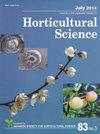Changes in Cell Number, Osmotic Potential and Concentrations of Carbohydrates and Inorganic Ions in Tweedia caerulea during Flower Opening
Journal of The Japanese Society for Horticultural Science
Pub Date : 2013-01-01
DOI:10.2503/JJSHS1.82.51
引用次数: 17
Abstract
The number of epidermal cells, osmotic potential, and carbohydrate and inorganic ion concentrations in petals during development and opening of Tweedia caerulea D. Don flowers was studied. The number of adaxial epidermal cells was greater than that of abaxial epidermal cells at all stages. The increase in cell number stopped at the stage just before flower opening. The size of adaxial and abaxial epidermal cells increased during flower development and opening. The results indicate that petal growth before flower opening depended on cell division and expansion, and petal growth during flower opening was attributable to petal cell expansion. Osmotic potential decreased and fructose, glucose and sucrose concentrations in the petals gradually increased during flower opening. Starch content and total inorganic ion concentration were almost constant during flower opening. Decreased osmotic potential is mainly attributed to increased glucose, fructose and sucrose concentrations. It is concluded that an increase in these sugar concentrations largely contributes to the decrease in osmotic potential. This decrease may facilitate water influx to cells, thereby maintaining pressure potential, which is apparently involved in petal cell expansion associated with flower opening.花期毛茛细胞数量、渗透势及碳水化合物和无机离子浓度的变化
研究了紫花Tweedia caerulea D. Don花发育和开放过程中表皮细胞数量、渗透电位以及花瓣中碳水化合物和无机离子浓度的变化。各时期近轴表皮细胞数均大于后轴表皮细胞数。细胞数量的增加在开花前阶段停止。在花的发育和开放过程中,正面和背面表皮细胞的大小逐渐增大。结果表明,开花前花瓣的生长主要依赖于细胞的分裂和扩增,开花后花瓣的生长主要依赖于花瓣细胞的扩增。花瓣中果糖、葡萄糖和蔗糖的浓度在开花过程中逐渐升高,渗透电位降低。开花期间淀粉含量和总无机离子浓度基本不变。渗透电位的降低主要是由于葡萄糖、果糖和蔗糖浓度的增加。由此得出结论,这些糖浓度的增加在很大程度上导致了渗透电位的降低。这种减少可能促进水流入细胞,从而维持压力势,这显然与花瓣细胞扩张有关。
本文章由计算机程序翻译,如有差异,请以英文原文为准。
求助全文
约1分钟内获得全文
求助全文
来源期刊
自引率
0.00%
发文量
0
审稿时长
>36 weeks

 求助内容:
求助内容: 应助结果提醒方式:
应助结果提醒方式:


